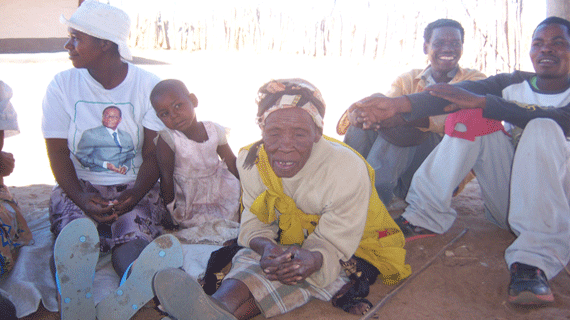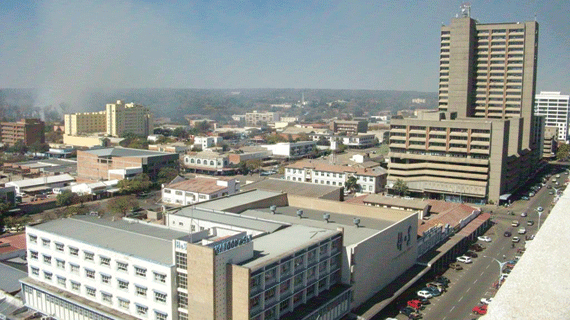
THE earth is baked beige, with hardly a blade of green and there has been another complete failure of the maize crop.
SILAS NKALA STAFF REPORTER
This best describes the Matabeleland region in the middle of yet another round of food shortages.
A Southern Eye crew that visited Tsholotsho in Matabeleland North witnessed and heard how most families, especially the San who were integrated into other communities, are facing outright starvation if the food crisis is not addressed as a matter of urgency.
Villagers in Mazibulala and Dlamini areas of Tsholotsho North told Southern Eye maize under the Grain Marketing Board’s grain loan scheme was last delivered in 2012 and if nothing is done, some villagers are most likely to die of hunger.
The villagers said only one non-governmental organisation (NGO), World Vision Zimbabwe, is trying to alleviate their suffering by engaging a few villagers under the food-for-work programme, but it is not enough as all villagers need food assistance.
Nkosimisile Dlamini said she was getting three meals a day for her family and they were among the few lucky villagers working under the World Vision’s food for work programme.
“We are working under the World Vision’s food-for-work programme where we are getting 50kg of maize, 10kg of beans and four litres cooking oil, but that food only lasts us two weeks and then we starve until the next pay day,” she said.
- Chamisa under fire over US$120K donation
- Mavhunga puts DeMbare into Chibuku quarterfinals
- Pension funds bet on Cabora Bassa oilfields
- Councils defy govt fire tender directive
Keep Reading
Dlamini said since World Vision had not engaged all willing villagers for food for work, the food they got lasted a few days because they shared it with their neighbours with absolutely nothing to eat.
Tsholotsho did not receive enough rainfall last season. Villagers did not harvest anything.
The food crisis in Tsholotsho is further worsened by lack of drinking water as the same hungry villagers have to travel for more than 4km to fetch it.
“We still work for more than 4km in our weak and hungry state to fetch water for human use and our domestic animals,” Matilda Sibanda of Mswiganya village in the Nyamazana area said.
“We have to endure a long day’s wait from morning to be able to draw water as the source is also drying up, which even makes our life more difficult.”
This is just a glimpse into the perennial food crisis that stalks the southern parts of Zimbabwe every year as a result of crop failure and poor harvests due to low rainfall patterns.
This annual food crisis always afflicts Matabeleland North and South, the Midlands and Masvingo provinces where families go for days without food.
A recent report by the World Health Organisation revealed that due to poor yields last season, over 2,2 million people will need food aid from January to March in 2014.
The report indicates that the challenge requires urgent government action in establishing a food reserve as a measure to contain the looming humanitarian crisis.
A Zimbabwe Vulnerability Assessment Committee 2013 draft report on rural livelihoods and assessment reveals that Matabeleland North and South had the highest proportion of communities reporting low crop yields.
The report also highlights the escalation of malnutrition cases in the Matabeleland provinces due to food shortages.
“It is worrying that 42% of children under five years were consuming two or fewer meals per day and therefore unlikely to access adequate nutrients necessary for their optimum growth,” the report reads.
“Therefore, nutrition programming for children should promote appropriate complementary feeding practices, especially within the window of opportunity “six-23 months.”
The report further reveals that the low prevalence of functional irrigation schemes in rural communities shows the high dependency on rain-fed cropping in rural Zimbabwe and this makes crop production highly vulnerable to climate variability.
“To address this challenge, irrigation rehabilitation and development is encouraged,” the report said.
It indicated that the government food support was most prevalent in Matabeleland South where 14% of the households were supported, while NGO support was significant in Masvingo where 12% of the households had benefited.
According to the report, places in Matabeleland South with a high prevalence of food insecurity at the peak hunger period are Gwanda, Matobo, Insiza and Bulilima.
Matabeleland North has high food insecurity in Hwange and Binga, while Tsholotsho is close to high with Nkayi, Lupane and Bubi in a better position than the first three.
In the Midlands only Gokwe North has high food insecurity and Masvingo has no district area with high food insecurity.
Tsholotsho Rural District Council chief executive officer Themba Moyo said San people were in serious need of food, but expressed hope that starvation would be eased since Jabulani Nkomo, son of the late Vice-President John Landa Nkomo, managed to source bread donation for them.
Moyo refused to shed more light on the issue referring Southern Eye to the district administrator Nosizi Dube who was not available for comment.
Creative Arts and Education Development Association director Davy Ndlovu said most of the San people are found in Tsholotsho North’s Ward 1 at Sakhile village, Ward 2 at Mazibulala, Ward 7 at Dam Locingo in Sanqinyana and Ward 8 in Gariya.
In Tsholotsho South, the San are only found in Ward 10 in the Mutshina and Emfuleni villages.
According to recent the Tsoro-o-Tso San Development Trust’s San census, there are 2 000 San people in Zimbabwe, with 457 found in Plumtree, eight in Matobo and 1 165 in Tsholotsho. Twitter feedback@silasnkala










